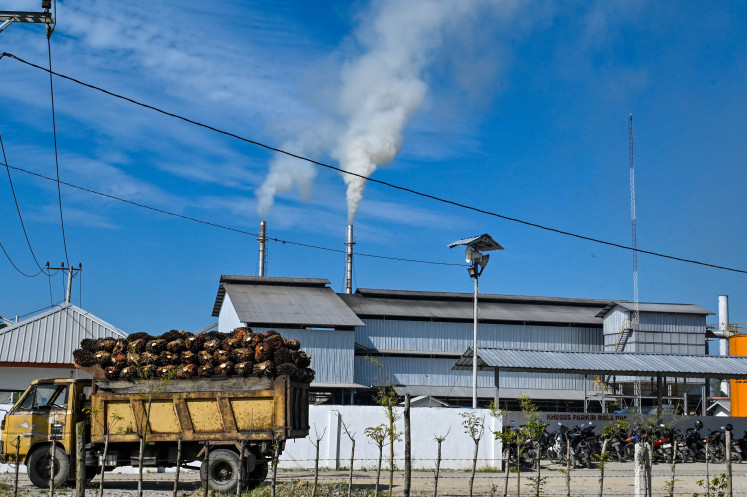Popular Reads
Top Results
Can't find what you're looking for?
View all search resultsPopular Reads
Top Results
Can't find what you're looking for?
View all search resultsRice husk waste turned into cheap energy for cooking
Millions of farmers in Indonesia could benefit from a simple gas stove which uses small scale rice husk gassification technology, turning rice husk waste into efficient fuel
Change text size
Gift Premium Articles
to Anyone
Millions of farmers in Indonesia could benefit from a simple gas stove which uses small scale rice husk gassification technology, turning rice husk waste into efficient fuel. This is an abundant farm waste in the country which produces about 58 million tons of rice a year.
The burner of the humble, metal cooking stove which generates a clear, blue flame was invented and developed initially in the Philippines and later in Indonesia by Alexis Belonio, a Philippina agricultural engineer, who has worked as a production director of PT Minang Jordanindo Approtech, since 1997.
"By using this stove a rice farmer can save up to about US$150 a year, compared to stoves using kerosene or liquefied petroleum gas. This saving is quite significant for hundreds of millions of people who still live on less than $2/day," Belonio said after receiving an award from Swiss Rolex SA at a special ceremony in Manila last Wednesday.
The multiple benefits of Belonio's invention are that rice husks are usually free, either on the farm or from the waste dumps near rice mills and the use of husk-fired stoves could reduce greenhouse gas emissions and cut down the use of firewood.
"Indonesia produced more than 10 million tons of rice husks a year and most of them were wasted. This is the huge potential resource I had in mind when I decided to sponsor Belonio's research and experiments as part of my company's search for clean, renewable energy," Minang Jordanindo Chairman Bonny Minang told The Jakarta Post.
Belonio was one of the ten recipients of the 2008 Rolex Awards for Enterprise which has honored innovators in various areas since 1976. Five of them were recognized as Rolex Laureates, who each received $100,000, with five other Associate Laureates each receiving a $50,000 prize, including Belonio.
The winners were selected from 1,500 applicants from more than 125 countries by an independent jury of internationally-known scientists, economists and other experts from various countries around the world.
The Rolex Awards fund new and ongoing projects which demonstrate a spirit of enterprise and address pressing needs around the world and winners are innovators who mostly work outside the mainstream and have limited access to traditional funding.
Emil Salim, an economist and former cabinet member having held different ministerial portfolios, was one of the 11 members of the jury for the 2008 Rolex Awards.
Belonio, a 48-year old associate professor of agricultural engineering at the College of Agriculture at the Central Philippine University in Iloilo City, acknowledged that cookers fired by rice husks had been used before, but they had been sooty and unhealthy and did not generate enough heat to cook quickly.
"But the gasification process I invented and the design I made for the gas stove is able to cook food or water very quickly as a ton of rice husks can generate energy to the equivalent of 415 liters of gasoline or 378 liters of kerosene, " he added.
His demonstrations in the Minang Jordanindo workshop showed that a few handful of husks can boil water in seven to nine minutes. Yet more beneficial is that cooking by the stove eliminates toxic fumes inside houses."Even the char left after burning rice husks can be recycled to improve soil nutrition or made into cardboard," Bonny said.
The early gas stove model he developed in the Philippines since 2003 was quite expensive, costing about $100, which is certainly not affordable to most rice farmers.
"But my research and experiments with sponsorhip from Minang Jordanindo helped develop a new design which cut down the cost of the gas stove to $25 per unit," Belonio said.
"But I want to further cut the cost down to only $10," Bonny said with a high sense of optimism.
Bonny added that Belonio had expanded his research and experiments to create a broad range of new technologies such as dual-reactor and continuous-flow gasifiers for grain dryers, bakery ovens, commercial kitchen stoves and micro-generating plant.
In Belonio's design, a stream of oxygen converts the burning rice husk fuel to a combustible blend of hydrogen, carbon monoxide and methane gase, yielding a hot, blue flame similar to that produced by burning natural gas.
Bonny said Belonio is also experimenting with a super-gasifier, a powerful rice-husk stove driven by injecting superheated steam, which can use other biomass feed-stock such as coconut husks, corn cobs and sugarcane bagasse.
Rice husk-fired cookers have been mass produced in the Philippines using Belonio's technology process.
However, Bonny is still hesitant to immediately commercialize Belonio's invention through mass production of the cheaper design and model developed under his company's sponsorship.
"There is not yet an organized market for rice husks in Indonesia. Mass producing this stove now could suddenly cause the price of rice husks, now mostly wasted, to skyrocket. Such conditions could cause a backlash on the introduction of this simple gas stove," he said.
Certainly, Bonny added, he wants his investment paid back, but " I am still selling this idea (rice husk-fired stoves) to the government with the objective of developing a reliable and stable source of rice husks, for example, through the opening of rice production estates as the agent of development."










